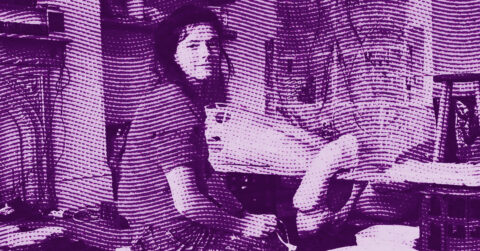Listen to me carefully, you bunch of snobs. David Salle offers us a masterful lesson on the fragmentation of the contemporary gaze, on this way in which our consciousness simultaneously absorbs disparate images, juxtaposes them without hierarchy, and yet manages to find meaning in them. For over four decades, this artist born in Norman, Oklahoma, in 1952, has manipulated and reconfigured our perception with an audacity that continues to defy even the harshest critics.
Salle emerged as a key figure in the 1980s, a time when New York oscillated between the feverish excitement of new artistic currents and the growing anxiety of a troubled era. He quickly became an essential member of what would later be called the “Pictures Generation”, those artists who questioned the status of the image through appropriation and the exploration of mass media. This young man, fresh out of the California Institute of the Arts, where he had studied under the tutelage of John Baldessari, distinguished himself by his audacity.
What strikes in Salle’s approach is this apparent nonchalance with which he combines heterogeneous imagery: a fragment of a classical painting sits next to a 1950s advertisement, an erotic photograph is superimposed on a schematic drawing. One might think it a simple game of anarchic collage, but behind this apparent chaos lies a formidable visual intelligence, a deep understanding of pictorial syntax.
Consider his “Pastorals” from the early 2000s, where he revisited classical bucolic landscapes with a vibrant palette and modern image inserts. Salle did not merely juxtapose these disparate elements; he created a new visual grammar, a language that reflects our fragmented experience of the world. “Certain images reveal something profound about the workings of the world; it seems they can access the very structure of consciousness,” he affirmed [1]. This phrase perfectly sums up his artistic ambition.
Consciousness, that is a concept that Salle has explored in a particularly interesting way through his work. By carefully observing his canvases, one can perceive a subtle reflection on the phenomenology of perception, not in the Merleau-Pontian sense you might imagine, but rather as an empirical exploration of how we integrate images into our stream of consciousness. Salle’s canvases are not windows onto a unified world, but multiple screens where different realities and temporalities collide.
What is particularly striking in Salle’s approach is how he manages to transcend the traditional limits of painting to create a pictorial space of remarkable elasticity. It is not simply about juxtaposing images, but about creating tensions, dialogues, sometimes confrontations between them. The figurative elements seem to float in a virtual space, defying the laws of perspective and gravity. This approach is reminiscent of certain cinematic techniques, such as montage and superimposition, which Salle has directly explored by directing the film “Search and Destroy” in 1995.
Cinematography, in fact, constitutes an essential reference for understanding Salle’s work. “Since I started painting, I have tried to achieve the fluidity and surprise of image connections, the simultaneity of cinematic montage, in painting,” he explained [2]. This cinematic influence is not limited to the formal structure of his works but extends to their very content. They often contain references to directors like Douglas Sirk, Rainer Werner Fassbinder, or Preston Sturges, whose ability to create visually rich and emotionally complex worlds Salle admired.
This cinematic dimension of Salle’s work leads us to consider another fundamental characteristic of his practice: its theatricality. Not only has Salle collaborated with choreographer Karole Armitage to create sets and costumes for numerous ballets, but his paintings themselves possess an undeniable scenic quality. The figures that appear in them often seem to play a role, taking deliberately dramatic or artificial poses. There is something of the tableau vivant in these compositions, a staging that reminds us we are facing representations, not realities.
This acute awareness of representation is at the heart of Salle’s work. By combining various pictorial styles within a single canvas, from abstract painting to hyperrealism, from line drawing to photographic reproduction, he forces us to become aware of the conventions that govern our perception of images. There is no unified style in Salle, but rather a constant exploration of the possibilities and limits of each mode of representation.
What is particularly interesting about this approach is how it reflects our contemporary experience of images. In the digital age, we are constantly bombarded with heterogeneous visual information: advertisements, films, photographs, works of art, all instantly accessible and often consumed simultaneously. Salle’s paintings, with their juxtaposition of seemingly unrelated images, anticipated this fragmented experience well before the advent of the Internet and social media.
But reducing Salle’s work to a mere commentary on media culture would be a mistake. His works are not theoretical manifestos, but sensitive and personal explorations of visual language. There is a deeply poetic dimension to his way of creating unexpected associations between images, of establishing emotional resonances through formal contrasts.
This poetic dimension is particularly evident in his “Tree of Life” series, created during the COVID-19 pandemic in 2020-2021. These works, which reference Adam and Eve, the Garden of Eden, and New Yorker cartoonist Peter Arno, testify to a new direction in Salle’s work. The canvases alternate between a black-and-white palette and a polychrome palette, creating a visual rhythm that evokes the variations of a musical composition. The reference to the “Tree of Life”, that mythical tree that connects heaven and earth, suggests an aspiration to unity, to connection, which contrasts with the fragmentation characteristic of his earlier works.
This recent evolution in Salle’s work is all the more interesting as it coincides with his exploration of artificial intelligence as an artistic tool. In 2023, he collaborated with computer scientists to create a program capable of generating images reflecting his style [3]. This approach might seem paradoxical for an artist whose work has always emphasized the deliberate selection and juxtaposition of images. But it also testifies to a constant intellectual curiosity, a willingness to push the boundaries of his practice.
Salle’s experience with AI raises fascinating questions about the nature of creativity and artistic originality. As he explains, he has “sent the machine to art school”, feeding it images of artists he considers fundamental, such as Arthur Dove for line, Edward Hopper for volume, De Chirico for space, Andy Warhol for color, as well as his own “Pastorals” [4]. This approach reveals a deep understanding of how artistic styles are constructed and transmitted, how they can be broken down into formal elements and then recombined to create something new.
There is something deeply ironic in this approach. Salle, whose work has often been criticized for its appropriation of pre-existing images, now finds himself in the position of seeing his own style appropriated and recombined by a machine. But this irony does not seem to bother him. On the contrary, he seems fascinated by the possibility of seeing his visual language transformed and extended by artificial intelligence.
This openness to transformation, this constant willingness to explore, is perhaps what best defines Salle’s career. From the provocative early works of the 1980s to recent experiments with AI, through his forays into cinema and set design, he has never ceased to challenge conventions and expand the field of possibilities.
What is remarkable is that despite this diversity of approaches, his work remains immediately recognizable. There is a Salle signature, not in the sense of a uniform style, but of a particular sensibility, a way of seeing and thinking about the visual world. As he himself has observed: “If you are a strong artist with a strong identity, you find your way” [5].
This strong identity is particularly evident in his relationship to artistic traditions. Salle is not an iconoclast who rejects art history; on the contrary, he actively incorporates it into his work, establishing dialogues with artists as diverse as Caravaggio, Giorgione, Watteau, or Picasso. But these references are never mere citations; they are transformed, decontextualized, and related to images from popular culture or the artist’s original creations.
It is this ability to navigate between different traditions, to create bridges between “high” and “low” culture, that makes Salle such an emblematic artist of our time. In a world where the traditional boundaries between artistic disciplines, between elite art and mass culture, are increasingly blurred, his work offers a model of creation that embraces this complexity rather than shying away from it.
And perhaps that is where the true significance of Salle’s work lies for our time. In a world saturated with images, where visual information is constantly fragmented, recombined, and decontextualized, his paintings offer not an escape, but a way to make sense of this experience. They show us how to navigate this complex visual landscape, how to find unexpected connections, emotional resonances, amidst the apparent chaos.
Critics have often accused Salle of coldness, of emotional detachment. But this reading misses the deep sensitivity that underlies his work. If his paintings sometimes seem distant or ironic, it is because they honestly reflect the ambivalence of our relationship to images in the contemporary world. We are both saturated and starved for images, cynical and naive in the face of their power.
Perhaps it is this honesty that gives Salle’s work its strength. He does not claim to offer simple answers or universal truths. Instead, he presents us with constellations of images, networks of potential meanings, and invites us to find our own way within them. In a world where grand narratives have lost their power, where certainties are crumbling, this open and exploratory approach seems particularly relevant.
David Salle reminds us that painting, far from being an obsolete medium in the digital age, remains a powerful tool for exploring and understanding our visual experience of the world. His works, with their deliberate complexity, their refusal of easy interpretations, force us to slow down, to look carefully, to establish our own connections. In a culture of instantaneity and rapid image consumption, this invitation to active contemplation is more precious than ever.
So the next time you find yourself in front of a Salle canvas, take the time to get lost in it, to follow the threads of his visual associations, to let yourself be surprised by his unexpected juxtapositions. For it is in this space between the images, in this play of resonances and contrasts, that the true power of his art is revealed. An art that does not seek to simplify our experience of the world, but to embrace its complexity, its contradiction, its chaotic beauty.
- Thaddaeus Ropac Gallery website, “David Salle”
- Artnet website, artist profile on “David Salle”
- “How to Train an Artistic AI”, David Salle, ArtReview, April 9, 2025
- The Guardian, “‘I sent AI to art school!’ The postmodern master who taught a machine to beef up his old work”, April 15, 2025
- Interview Magazine, “David Salle Has a Headline in Mind for This Interview”, November 6, 2023
















